

 The South African
The South African
With special acknowledgement to the late Lionel Wulfsohn
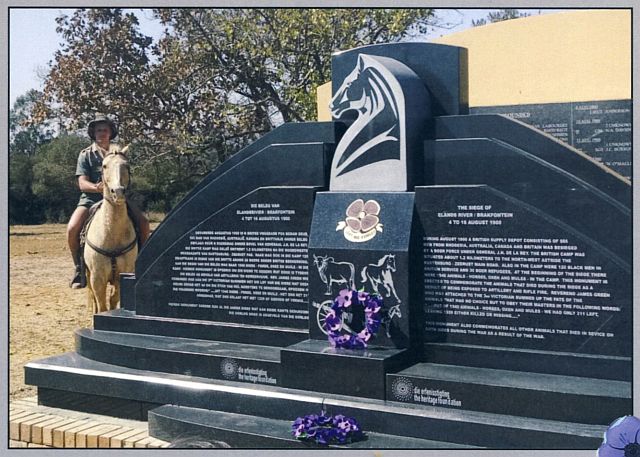
The memorial
On Saturday, 17 August 2019, a Memorial Service was held to commemorate the Siege of Elands River, 4-16 August 1900 during the South African War (often also known as the Anglo-Boer War of 1899 to 1902). The focus of this year’s service was the unveiling of a monument to the memory of the many animals that died as a result of warfare. Major John Pennefather (retd) of the Magaliesberg Military History Society, was the driving force behind the Swartruggens Project.
On arrival at the special memorial service, guests were presented with a Purple Poppy instead of the traditional Red Poppy that is worn every November to commemorate to remember the fallen men and women who lost their lives during the two World Wars. The new version of the poppy was initially launched in the United Kingdom in 2006, by a charity known as Animal Aid, in remembrance of the very many animals that have died as a result of war, or of human exploitation. [An article on the Purple Poppy by Capt Charles Ross (retd) appeared in the previous issue of the Military History Journal, Volume 18 No 4, June 2019, p162]. But what was the link between Elands River and animals lost in war?
It is not generally known that the Elands River action was probably the greatest deliberate slaughter of horses and draught animals during the South African War. About two-thirds of the 1 500 horses, oxen and mules at Elands River were killed by artillery and rifle fire during the twelve-day siege by a Boer force of about 3 000 men.
Master of Ceremonies, Mike Benn, Chairman of the Magaliesberg Association for Culture and Heritage, presiding, welcomed the guests attending the service, who numbered over 200. He thanked Maarten Stols, the owner of the farm on which the memorial and museum now stand, near the main tactical feature defended by Captain Butters and 80 Southern Rhodesia Volunteers. Colonel John Redfern (retd) played a key role in building the Elands River Centenary Memorial, opened on 5 August 2000, to honour the Rhodesians killed in the action at Elands River, and to record their valiant stand, under extreme conditions, together with their Australian and British comrades, and the opposing Boer commandos. Maarten Stols financed the museum and the archaeological excavation of the trenches himself, and the removal of artefacts from the military section of the Swartruggens Cemetery, sadly now vandalised.
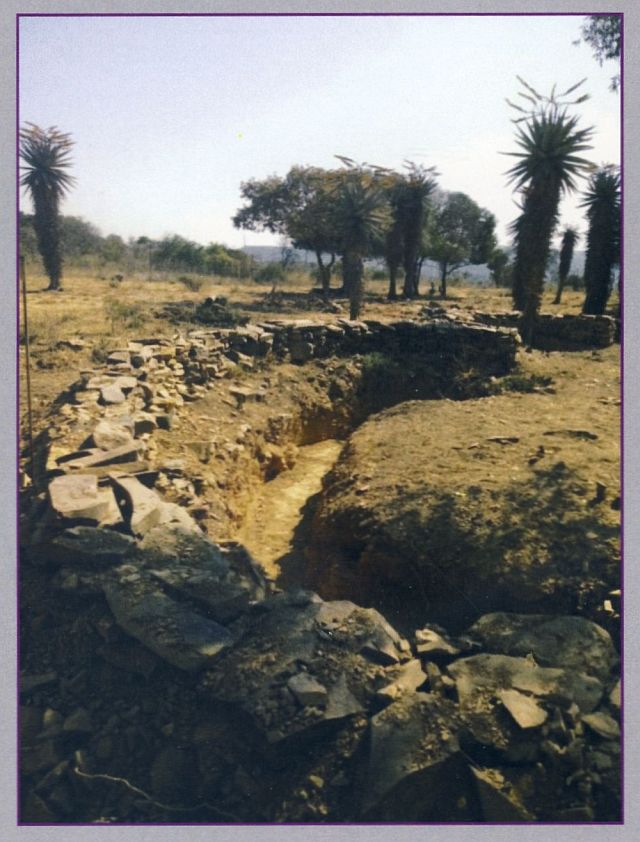
The trenches at Elands River.
Ds Stephan Botha, of Groot Marico, gave the introductory talk on the Siege and led the Dedication Service in prayer for both monuments. Prof Jan Myburgh of Onderstepoort gave an insightful talk on the effects of warfare on animals. Mounted riders on horseback took up positions on both flanks of the memorial and ‘The Last Parade’, a poem by Banjo Patterson, was read by historian Vincent Carruthers.
Major John Pennefather and his wife, Irma, were called forward to unveil the impressive Animal Monument and the Wall of Remembrance. A mission fulfilled! In his brief comments, John referred to the animal casualties as the greatest deliberate slaughter of draught animals during the conflict, and the tremendous attrition of animals throughout the war, including those lost during the farm clearances of the ‘Scorched Earth’ policy. He said that he was fully supported in this endeavour and encouraged by his wife, Irma, to whom he referred as his own ‘Commander-in-Chief’! He expressed his sincere gratitude to the many people and organisations who had made generous contributions towards the funding and erection of this animal the funding and erection of this animal monument, including the Heritage Foundation. The Memorial was then unveiled.
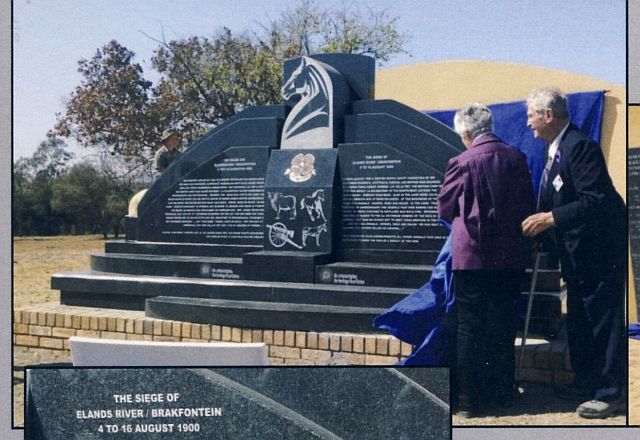
Monument unveiled
The audience stood to attention, while ‘The Last Post’ was played, in a very touching moment, with many a tear being fought back at the memory of the brave men and so many, many animals that had died during the course of this battle, and in the many other wars since.
Wreaths were laid and then Mike Benn introduced Peet Coetzee, Curator of the Museum. During his term as Curator, Peet had spent many years in research, and had also excavated many trenches with a pick and shovel. His grandfather had been among the Boer commandos who had besieged the Elands River Post, on the opposite side to men such as John Redfern’s grandfather, who had served with the SRV. Peet paid a warm tribute to Maarten Stols as he introduced his new book on the Siege of Eland's River and presented complimentary copies to John Pennefather and Maarten Stols. This drew the formal proceedings to a close.
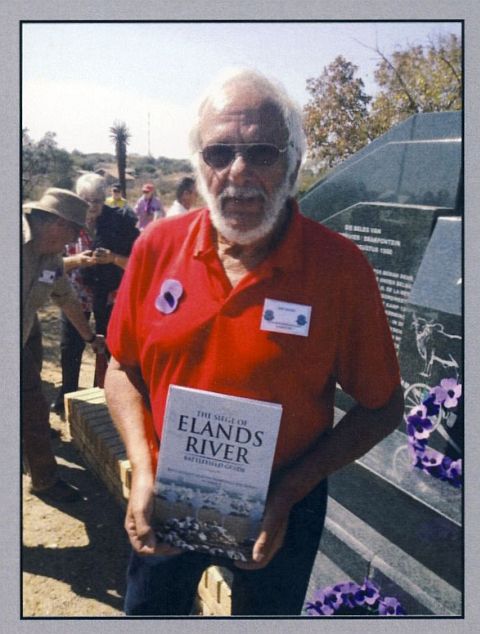
Peet Coetzee, Curator of the site museum.
Guests were then hosted to a delightful lunch of snacks, prepared and served by Mrs Stols and her team. Afterwards, Peet described the terrain of the battle site on an illuminated topographic model in the museum. There was a great interest in his battlefield guide and many copies were signed and sold. Guided tours to Butter's Kopje and the Cemetery were on offer to those who were interested. We left the site in a sombre and reflective mood, thankful that the men and the animals of the Siege of Elands River are being commemorated and will be remembered in the memorials and museum at the site.
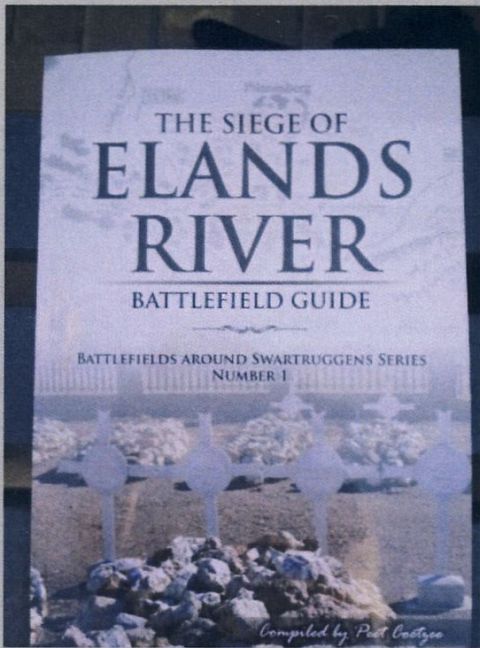
Peet's Guidebook
Acknowledgements
With grateful acknowledgements to the late Lionel Wulfsohn, Major John Pennefather, Colonel John Redfern, Maarten Stols, Peet Coetzee, Bruce Harrison, and the various speakers and organisers whose efforts all made this perfect, historic occasion possible.
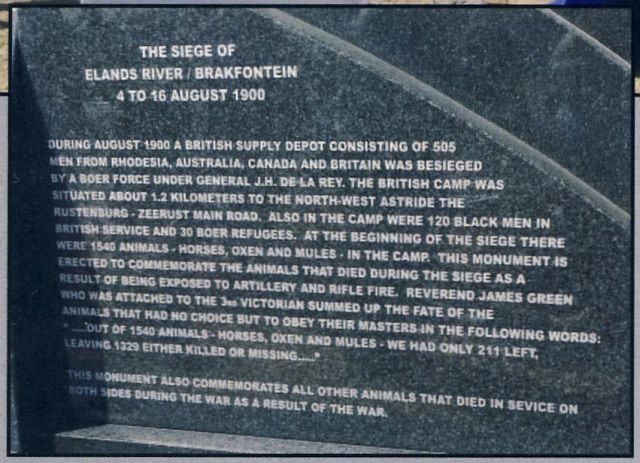
The English inscription
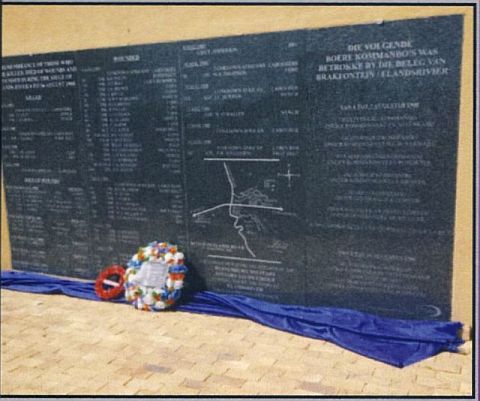
The map and names on the memorial wall
The British forces had established a Supply and Remount Post on the farm, Brakfontein, near to the town of Swartruggens, on the road between Mafeking and Pretoria, under command of Col H L Hore. The Rhodesian Field Force, about 550 men, together with a number of Australians and British troops and African labourers, formed the garrison.
At first light, about 06.00 on Saturday, 4 August 1900, the Boers under the command of General J H de la Rey, bombarded the post with heavy shells and rifle fire from all directions. For some, only the wagons and stores provided any form of protection from the shrapnel and the hail of bullets. The effort made to dig trenches in the rock-hard ground was useless. The position occupied by Captain Butters and the brave men of the Southern Rhodesia Volunteers on the rocky hillside was soon covered with the blood of the men and the many animals who died there. Destruction of the draught animals immobilised the defending force. At nightfall, the Boers ceased fire and the defenders used the opportunity to urgently improve their positions. Throughout the night they dug shell-proof shelters in the rocky kopje on which their camp was sited.
General de la Rey believed that the Supply Post was of tactical importance. Colonel Hore refused their offer of an Honourable Surrender. Relieving columns from the East (Baden-Powell) and West (Carrington) both turned back prematurely, and no reinforcements arrived in time to be of any significant help to the defenders. Relief from Lord Roberts’ column arrived only after the Boers had moved on. The attack resulted in the deaths in action of five combatants and eight non-combatants, and seven combatants died later from their wounds. Another 66 men were wounded. Four Boers are said to have lost their lives. The death toll among the animals was horrific. It was recorded that, from 1 540 animals (horses, mules and oxen) at the start of the battle, there were only 211 left at the end, the rest either killed or missing! [An excellent account of the siege and its consequences by the late Lionel Wulfsohn of Rustenburg was published in the June 1984 issue of the Military History Journal.]
Return to Journal Index OR Society's Home page
South African Military History Society / scribe@samilitaryhistory.org